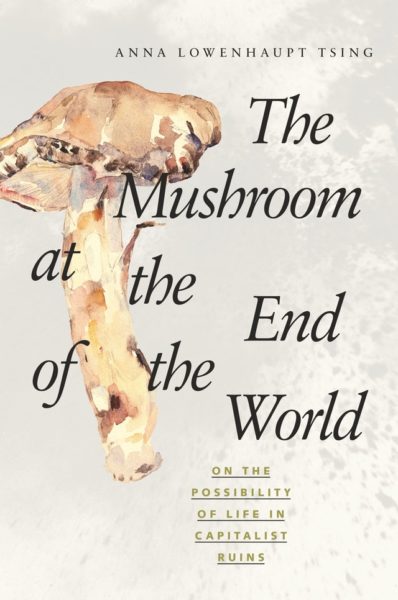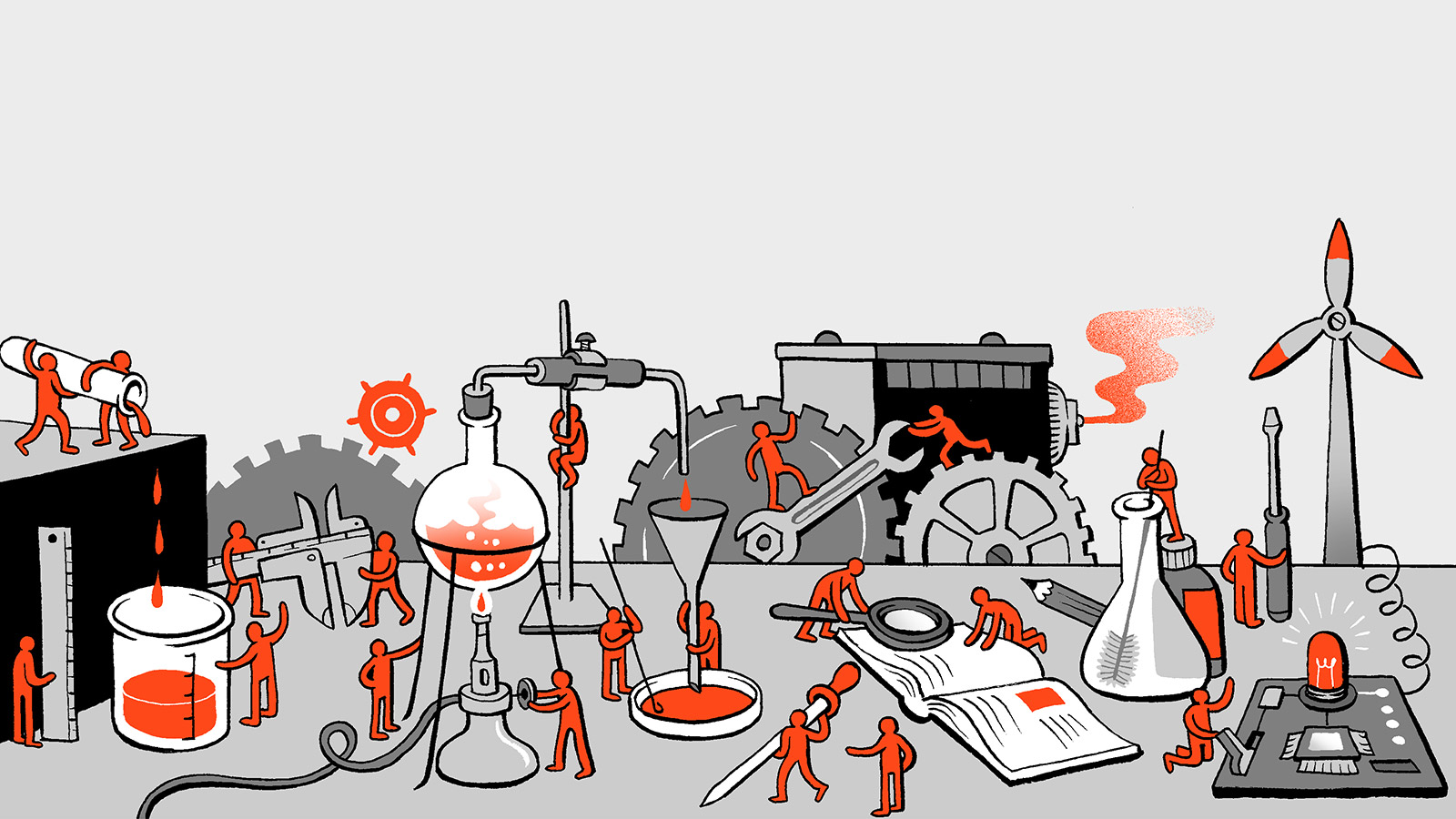Foraging Connections
A Review of Anna Tsing’s The Mushroom at the End of the World: On the Possibilities of Living in Capitalist Ruins
By Thomas Zauner
Volume 23, number 1, Science Under Occupation

How can we approach and analyze the myriad interwoven relations between humans, animals, plants, and fungi? In her book The Mushroom at the End of the World: On the Possibilities of Living in Capitalist Ruins, the anthropologist Anna Tsing uses the matsutake mushroom to explore the network of symbiosis, dependencies, and antagonisms that form its ecology, its history, and its economic use.
Tsing sets her work into the context of the Anthropocene. She argues that this age began with the advent of capitalism, but rejects the focus on humans, the “anthropos,” because both human and non-human life are under threat of capitalist commodification and alienation. Here, Tsing extends the Marxist use of “alienation” from the worker’s detachment from their labor to also mean separation of non-human entities from their livelihoods. This alludes to Jason Moore’s concept of the “Capitalocene” and the term “Plantationocene” discussed by Anna Tsing, Bruno Latour, Isabelle Stengers, and Nils Bubandt as an alternative to the Anthropocene.1 Tsing suggests that “precarity” (acknowledging our vulnerability toward others) and indeterminacy are critical in analyzing our times and that we must consider both human and non-human relations. The world is thus a set of assemblages of people, animals, plants, fungi, and things, embedded in different forms of political economy and struggles, connected by what she calls “latent commons,” that is, “entanglements that might be mobilized in common cause.”
While the book’s worldview illustrates fascinating interconnections, Tsing does this in a fashion as patchy and entangled as her fungal subject, jumping between themes of ecologies, histories, and economics.
Fungal and human networks
The matsutake mushroom is highly priced and valued in Japan. It grows in symbiosis with pines and oaks, exchanging water and minerals it extracts from the ground for energy-rich nutrients. The mushroom does not grow in nutrient-rich soils, as it is outcompeted by other fungi and bacteria there. Instead, matsutake flourishes in disturbed forests with bare grounds and degraded soil created by non-human events or by humans using the forest.
What counts as disturbance depends on the historically and socially situated stance toward “naturalness” of a forest and how it is studied, rationalized, and performed. In Japan, matsutake, forests, and humans have cultivated each other in “satoyama” peasant forests used by farmers, encouraging matsutake growth in disturbed soil. All three actors are ecosystem engineers implementing a common unintentional design on the landscape. Human influence in these woods decreased drastically due to the migration of farmers into Japan’s cities after the Second World War. Currently, little to no matsutake grows in Japan, so it is imported from other places, such as Oregon in the United States or Yunnan in China.
The managed “naturalness” in satoyama peasant landscapes in Japan contrasts with Western ideas of “naturalness” as undisturbed nature. In Oregon, forests ruined by former timber production now function as disturbed places for matsutake to grow and forestry services work on minimizing disturbance by humans, but in Japan, there even exists a movement for the restoration of managed satoyama forests. Tsing emphasizes how these different ideas of “naturalness” are studied and managed by mushroom pickers, forestry services, and local officials. She avoids the simple dichotomy of a nature/culture divide, showing how human and non-human participants in these networks form symbioses and antagonisms while pursuing their goals.
In Oregon, white colonizers dispossessed Indigenous communities of their land for timber production, which ceased in the second half of the twentieth century due to falling world market prices and cheap wood exported from Southeast Asia. The woods are left derelict as capitalist ruins formed by these historical conditions.2 Wildfire suppression by the forestry service changed the forest ecology, enabling long-lived lodgepole trees to form a symbiosis with matsutake. This is an element of unintentional landscape design in messy encounters.
Tsing follows mushroom pickers in Oregon, investigating their livelihoods and narratives in detail. Many pickers came from Southeast Asia decades ago as war refugees. The Lao, Cambodian, Hmong, Khmer, and Mien people each approach the mushroom hunt in a different fashion while they form temporary communities in the woods during picking season. Some recreate memories of village life in order to flee marginalization and violence in the cities. Others take up stories of the wars they or their parents fled by dressing in camouflage. Latinx pickers (largely undocumented) and white Americans seek matsutake mushrooms too, but stay apart from the other groups. Tsing talks to these pickers and illustrates their motivations, such as surviving war trauma and seeking US citizenship. Their lifestyles are ideal for commercial foraging, which draws pickers into the forest to follow the “mushroom fever.” For all of the pickers, picking matsutake is not traditional wage work, but a vocation and an enactment of freedom.
The mushroom retains personal entanglements to pickers, buyers, and the landscape that produced it. Only later it becomes sorted by exporters into capitalist inventory, fully alienating it from its context and commodifying it. In Japan, the matsutake is also a commodity, but one that, through centuries of traditional use as a valuable gift, is imbued with personal and cultural significance for buyer and seller.
People foraging for matsutake in the US Pacific Northwest participate in what Tsing calls “salvage accumulation”—the accretion of capital without controlling the conditions under which commodities are produced—a central property of capitalism. At such “pericapitalist” sites, both capitalist and non-capitalist forms of value coexist—the matsutake’s monetary value as well as the pickers’ various forms of freedom or tradition. There, these values can be translated into each other and move along a supply chain, transforming the matsutake from an object with various cultural associations into a piece of alienated inventory. Tsing illustrates mechanisms of translation between pickers, buyers, and vendors in the matsutake salvage supply chains, showing the networked histories of refugees, war, exploitation, and precarity on the one hand, and human to non-human cooperation on the other.
Conclusion
When Tsing speaks of the forest’s force and its resurgence after disturbance, I am reminded of the destructive and regenerative power of nature in Hayao Miyazaki’s film Nausicaä of the Valley of the Wind.3 Tsing’s vivid descriptions of matsutake ecology, genetics, and foraging under the guidance of different pickers shows that listening to the assemblages of humans and non-humans is a more-than-human political act. She states that to “listen politically is to detect the traces of not-yet-articulated common agendas.” She argues for considering mutualistic and antagonistic human and non-human relationships as latent commons that can be mobilized for building a common, imperfect livelihood; that cannot be easily institutionalized; that will not usher in a utopia of commons, but remain in the troubled present. The variability and unevenness of salvage supply chains elude an overarching common narrative, but by paying attention to difference, shifting categories, and boundaries formed by humans and non-humans, we can tap into these latent commons for solidarity.
The intentional patchiness of this book is imbued with Tsing’s curiosity, but can also make it difficult to follow a single train of thought, as topics are repeatedly approached from different angles. This iterative mode of reflection and reconsideration derives from the anthropological methods and makes for engaging reading. Tsing does not venture much into esoteric analysis and system-wide generalization, but stays on the ground and with the trouble, showing less of a vision for alternative futures in revolution, but a guide to an endangered present in solidarity.4
Anna Lowenhaupt Tsing
The Mushroom at the End of the World: On the Possibilities of Living in Capitalist Ruins
Princeton University Press
2015
352 pages
About the Author
Thomas Zauner shifted from quantum physics to science and technology studies in Vienna, Austria, and works as an activist and organizer.
References
- Jason W. Moore, “The Capitalocene, Part I: On the Nature and Origins of Our Ecological Crisis,” The Journal of Peasant Studies 44, no. 3 (May 4, 2017): 594–630; Bruno Latour, Isabelle Stengers, Anna Tsing, and Nils Bubandt, “Anthropologists Are Talking–About Capitalism, Ecology, and Apocalypse.” Ethnos 83, no. 3 (May 27, 2018): 587–606.
- Anna Lowenhaupt Tsing, Heather Swanson, Elaine Gan, and Nils Bubandt, eds., Arts of Living on a Damaged Planet (Minneapolis: University of Minnesota Press, 2017).
- Nausicaä of the Valley of the Wind, film, directed by Hayao Miyazaki, Tokyo: Studio Ghibli, Inc., 1984.
- Donna Haraway, Staying with the Trouble: Making Kin in the Chthulucene (Durham: Duke University Press, 2016).





